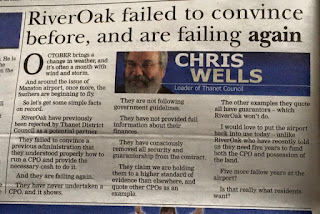As it gets closer to the 29th October the propaganda war has intensified with Riveroak leaking their solicitors Wragge's advice out into the public domain with the view to pushing their supporters into making a major effort to seek to influence the Councillors at TDC.
It must be recognised that TDC have been here before when Iris Johnston and her colleagues came to the same conclusion over Riveroak that Chris Wells and his colleagues must come to. The advice that they used to come to this conclusion was given and is reproduced below and is actually the same as Wragges have given Riveroak. The only difference is in its interpretation. The advice is reproduced below. I have added my comments between the pictures however their are two fundamental issues.
Firstly "The overarching public interest test is
whether there is a compelling case in the public interest" There are many on the pro side who believe that the public interest is served by making planes fly again from Manston. However for many different reasons that is fundamentally flawed.
Jobs: Riveroaks 5 year plan only envisages 139 jobs
Environmental: It has long been known that planes, especially 747's, are polluting and at only 800ft over Ramsgate noisy as well.
Profitability: In the last 20 years it has never made a profit.
Secondly "Before proceeding to any CPO the
Council should seek further information on their plans for the site from the
new owners" There is no evidence that TDC has ever discussed with Mssrs Cartner & Musgrave what they intend to do with the site. This is mainly due to their perception that they are only currently deciding whether Riveroak will make a suitable indemnity partner.
Advice given to TDC December 2014
1. The Council cannot be expected to take a leap of faith.
It must consider its ability to meet the tests set out in statute (section 226
TCPA 1990) and the Circular 06/04 on the evidence available to it in order to
justify proceeding with a CPO (and to assess whether to do is worthwhile in
light of the likelihood of it being confirmed by the Secretary of State if
necessary).
2.
The Council need
to be satisfied in promoting the CPO that it is able to meet the tests of
Circular 06/2004 on the likelihood of the project going ahead. The Secretary of State will not confirm a CPO
unless he is satisfied that there is a real likelihood of the project going
ahead. If the Council take the decision
to pursue a CPO, members would want to have assurance that a partner would take
this forward. The Secretary of State will need to be satisfied that the scheme
is likely to go ahead based on a realistic assessment. (Advice is given in Circular 06/04 paras 16 –
23, and Appendix A paragraph 16).
3.
It may be that a
scheme is not intended to be independently financially viable. Or it may be
that the viability is uncertain. If so, it is necessary to consider where
financial contributions will come from, and whether the Council itself would
underwrite any shortfall. Evidence as to this will have to be produced in due
course. In many cases, say for town centre redevelopment, it is not uncommon
for the scheme to be promoted in partnership with a substantial and financially
sound developer (e.g. a large supermarket chain) which will have entered into
an indemnity agreement with the local authority. If so, then evidence must be
available (subject to confidentiality considerations) to show that there is a
real prospect of the scheme going ahead based upon assessments of scheme
viability. In many cases, the S151 officer will be expected to certify (e.g. in
a witness statement) that he was satisfied that the project was viable and/or
that the local authority (or some other funding source) would meet any funding
shortfall if the partner investment was not forthcoming, or provide evidence
that the viability of the scheme had been independently assessed and the
necessary agreements to deliver the scheme are in place. In the latter
circumstances, evidence in relation to this may well be provided by the
development partner. The key question in considering these financial issues is
whether the Council will be able to show that there is a real prospect that the
scheme will proceed, and to do so will provide as much information as possible
as to the resource implications of proceeding (see in particular paragraphs 20
and 21 Circ. 06/04 and Appendix A para 16(iii). As noted above, the Council
must be in a position to form a view on these matters in resolving whether to
make a CPO.
4.
If the Council
is unable at the outset to be satisfied that the key resource and financial
tests are not fulfilled at the start, it would be very difficult to move forward
unless they have a high degree of confidence that these matters will be
addressed shortly. This also begs the
question as to why should the Council progress before receiving the necessary
assurances?
5.
The new
ownership of the site since previous legal advice will be a major factor when the
Council is deciding to make the CPO and when the Secretary of State is deciding
whether or not to confirm a CPO. The overarching public interest test is
whether there is a compelling case in the public interest. As the Circular
advises (17), an authority should be sure that the purposes for which it is
making the CPO sufficiently justify interfering with the human rights of those
with an interest in the land affected.
6.
It should be emphasized
that any decision to make a CPO requires proper consideration of a likely
interference with the owners’ human rights. Before proceeding to any CPO the
Council should seek further information on their plans for the site from the
new owners. The Council must be in a position to assess the degree of
interference with the landowner’s human rights, and also, if appropriate, to
consider the benefits of their alternative proposals for the site to strike the
public interest balance.
7.
In seeking to
justify any CPO the Council would have to show that the benefits of what it
proposed would be so extensive that (notwithstanding the merits of the new
owners’ proposals) the public interest v human rights balance would still be in
favour of the CPO.
8.
It should be
remembered that a CPO is a last resort. Counsel does not agree with the
implication (if this is the implication) within James Maurici QC’s advice to
RiverOak that the Council should not seek to negotiate with the owners of the
land with a view to determining whether a negotiated sale is possible. Counsel would not advise against attempting
to negotiate. Indeed, in order to strike the balancing exercise properly (and
safely) it is in the Council’s interest to understand the new owner’s position,
and their intentions for the land.
9.
The approach
taken to determine whether the prospective indemnity partner is suitable before
embarking on any CPO appears reasonable.







No comments:
Post a Comment